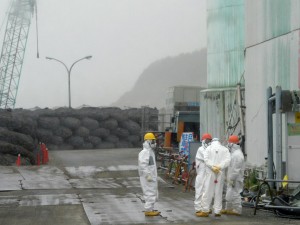Japan moves closer to restarting nuclear reactors

Workers take a break at Japan’s Fukushima Dai-ichi nuclear plant in Okuma town in Fukushima prefecture on June 12, 2013. AFP FILE PHOTO
TOKYO – Japan moved a step closer to restarting nuclear reactors Monday as four utility companies applied for safety inspections of 10 idled plants, the clearest sign of a return to atomic energy nearly two and a half years after the Fukushima disaster.
With all but two of the country’s 50 reactors offline since a tsunami swept through the Fukushima Dai-ichi plant in March 2011, Japan has been almost without nuclear energy that once supplied about a third of its power.
Four Japanese nuclear plant operators — supplying the regions of Hokkaido, Kansai, Shikoku and Kyushu — Monday filed applications for inspections by the Nuclear Regulation Authority for 10 reactors at five plants under new safety requirements that have just come into effect.
Applications for two more reactors are expected later in the week.
Reactors that pass the stricter rules will possibly be allowed to restart early next year, with each inspection expected to take several months. Critics say the rules have loopholes, including grace periods for some safety equipment.
Article continues after this advertisementHit by soaring gas and oil costs to run conventional power plants to make up the energy shortfall, Japanese utility companies have lobbied hard to put their reactors back online.
Article continues after this advertisementNearly all the utilities that own nuclear power plants reported huge losses last fiscal year due to higher costs for fuel imports. Hokkaido Electric Power Co. said it has been hit with additional daily fuel costs of 600 million yen ($6 million) to make up for three idled reactors. Nuclear operators have requested rate hikes or plan to do so.
Prime Minister Shinzo Abe has pushed for restarts since taking office in December, freezing the previous government’s nuclear phase-out plan. Resumption of nuclear power plants is part of his ruling party’s campaign platform in parliamentary elections in two weeks.
New rules for the first time require plants to guard against radiation leaks in the case of severe accidents, install emergency command centers and enact anti-terrorist measures. Operators are required to upgrade protection for tsunamis and earthquakes, as well as tornadoes and aviation accidents.
Safety was previously left up to the operators, relying on their self-interest in protecting their investments as an incentive for implementing adequate measures. Tokyo Electric Power Co. came under fire for underestimating the risk of a tsunami and building a seawall that was less than half the height of the wave that hit its Fukushima Dai-ichi plant and caused multiple meltdowns and massive radiation leaks. About 160,000 evacuees still cannot return home.
Ikuo Morinaka, senior official at Kansai Electric Power Co., which is applying to restart four reactors in Fukui prefecture that supply power to large parts of western Japan, said the company has taken emergency measures and additional steps since the Fukushima disaster.
“We are ready,” Morinaka said after handing a thick file of documents to a watchdog official at a media-packed ceremonial event.
Dozens of activists opposing nuclear power staged rallies outside a building that houses the watchdog’s office, holding banners and chanting anti-nuclear slogans.
Critics say the new safety requirements have loopholes that make things easier for operators, including a five-year grace period for some of the mandated steps given to reactors known as PWRs. They come with larger containment chambers considered less likely to suffer from pressure buildup than ones like those ravaged at Fukushima. This means half of the 48 reactors that use a pressurized water system could operate without the features for up to five years.
All 10 reactors set for inspections are PWRs, and filtered vents and command centers are still not completed at many of them.
The approvals are aimed at resuming reactor operations even though nearby communities lag in enacting needed emergency and evacuation procedures, and the restarts will cause more nuclear waste, plutonium stockpiles and other safety and environmental risks, said a group of experts headed by Hosei University sociologist Harutoshi Funabashi.
The critics say running nuclear plants will eventually become a financial burden, as safety upgrades under the new requirements add up and the cost of decommissioning aging reactors and waste cleanup. Even initial safety upgrades are estimated to exceed a combined total of 1 trillion yen ($10 billion).
TEPCO, struggling with huge compensation and disaster cleanup costs, wanted to apply to restart two reactors in Niigata, central Japan, but was forced to postpone that amid local protests.
Niigata Gov. Hirohiko Izumida on Friday accused TEPCO President Naomi Hirose of ignoring the local communities.
“Money or safety, which is more important,” he said.